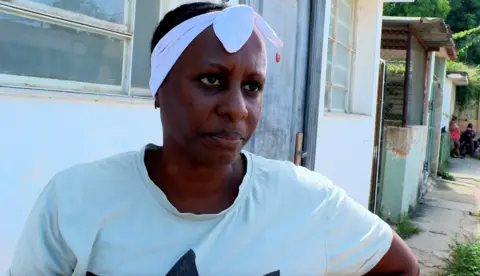 BBC
BBCCuba has endured one among its hardest weeks in years after a nationwide blackout which left round 10 million Cubans with out energy for a number of days. Including to the Caribbean island’s issues, Hurricane Oscar left a path of destruction alongside the north-eastern coast, leaving a number of lifeless and inflicting widespread harm. For some communities in Cuba the vitality disaster is the brand new regular.
As Cuba approached its fourth day with out energy this week, Yusely Perez turned to the one gas supply left obtainable to her: firewood.
Her neighbourhood in Havana hasn’t obtained its common deliveries of liquified fuel cannisters for 2 months. So as soon as the island’s complete electrical grid went down, prompting a nationwide blackout, Yusely was pressured to take determined measures.
“Me and my husband went all around the metropolis, however we couldn’t discover charcoal anyplace,” she explains.
“We needed to acquire firewood wherever we discovered it on the road. Fortunately it was dry sufficient to prepare dinner with.”
Yusely nodded on the yucca chips frying slowly in a pot of lukewarm oil. “We’ve gone two days with out consuming,” she provides.
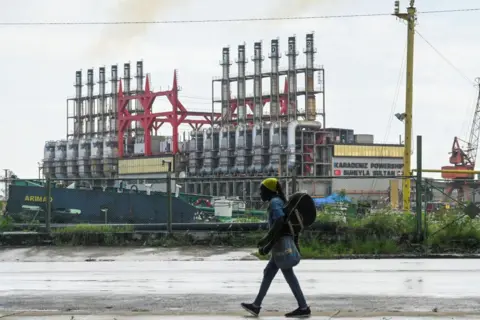 AFP
AFPTalking final Sunday, on the peak of what was Cuba’s most acute vitality disaster in years, the nation’s vitality and mines minister, Vicente de la O Levy, blamed the issues for the nation’s creaking electrical infrastructure on what he referred to as the “brutal” US financial embargo on Cuba.
The embargo, he argued, made it not possible to import new components to overtake the grid or usher in sufficient gas to run the facility stations, even to entry credit score within the worldwide banking system.
The US State Division retorted that the issues with vitality manufacturing in Cuba didn’t lie at Washington’s door – however argued that it was as a result of Cuban authorities’s personal mismanagement.
Regular service can be resumed quickly, the Cuban minister insisted. However no sooner did he utter these phrases than there was one other whole collapse of the grid, the fourth in 48 hours.
At evening, the complete extent of the blackout turned clear.
Havana’s streets had been plunged into close to whole darkness as residents sat on the doorsteps within the stifling warmth, their faces lit up by their cell phones – so long as their batteries lasted.
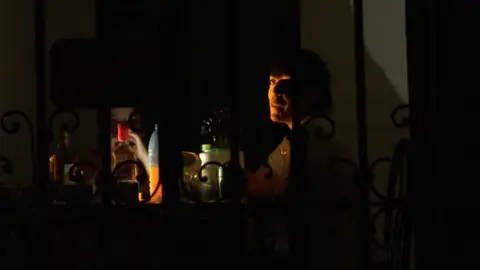
Some, like restaurant employee Victor, had been ready to brazenly criticise the authorities.
“The individuals who run this nation are those who’ve all of the solutions,” he says. “However they’re going to have to clarify themselves to the Cuban folks.”
Particularly, the state’s resolution to take a position closely in tourism, somewhat than vitality infrastructure, annoyed him most throughout the blackout.
“They’ve constructed so many resorts previously few years. Everybody is aware of {that a} lodge doesn’t value a few bucks. It prices 300 or 400 million {dollars}.”
“So why is our vitality infrastructure collapsing?” he asks. “Both they’re not investing in it or, if they’re, then it’s not been to the advantage of the folks.”
Conscious of the rising discontentment, President Miguel Diaz-Canel appeared on state TV sporting the standard olive-green fatigues of the Cuban revolution.
If that message wasn’t clear sufficient, he instantly warned folks in opposition to protesting over the blackout. The authorities wouldn’t “tolerate” vandalism, he mentioned, or any try and “disrupt the social order”.
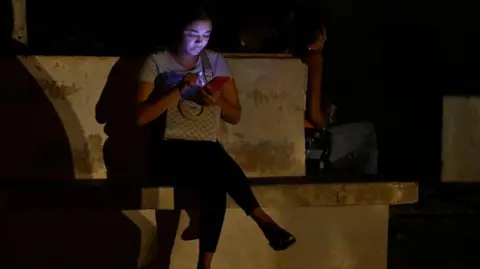 AFP
AFPThe protests of July 2021, when a whole lot had been arrested amid widespread demonstrations following a sequence of blackouts, had been recent within the reminiscence.
On this event, there have been solely a handful of stories of remoted incidents.
But the query of the place Cuba chooses to direct its scarce sources stays an actual level of competition on the island.
“Once we speak about vitality infrastructure, that refers to each technology and distribution or transmission. In each step, quite a lot of funding is required,” says Cuban economist, Ricardo Torres, on the American College in Washington DC.
Electrical energy technology in Cuba has just lately fallen nicely under what’s required, solely supplying some 60-70% of the nationwide demand. The shortfall is a “big and severe hole” which is now being felt throughout the island, says Mr Torres.
By the federal government’s personal figures, Cuba’s nationwide electrical energy technology dropped by round 2.5% in 2023 in comparison with the earlier 12 months, a part of a downward pattern which has seen a staggering 25% drop in manufacturing since 2019.
“It’s vital to know that final week’s downside within the vitality grid isn’t one thing that occurs in a single day,” says Mr Torres.
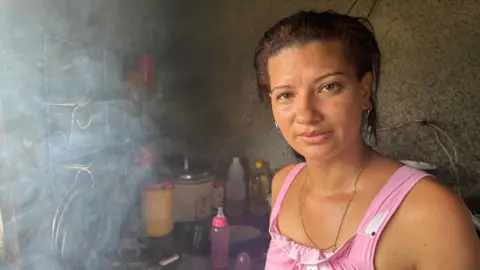
Few know that higher than Marbeyis Aguilera. The 28-year-old mother-of-three is getting used to residing with out electrical energy.
For Marbeyis, even “regular service” being restored nonetheless means many of the day with out energy.
In actual fact, what the residents of Havana endured for just a few days is what day by day life is like in her village of Aguacate within the province of Artemisa, outdoors Havana.
“We’ve had no energy for six days”, she says, brewing espresso on a makeshift charcoal range inside her breeze-block, tin-roofed shack.
“It got here on for a few hours final evening after which went out once more. We now have no selection however to prepare dinner like this or use firewood to offer one thing heat for the kids,” she provides.
Her two fuel hobs and one electrical ring sit idle on the kitchen prime, the room filling with smoke. The group is in dire want of state help, she says, itemizing their most pressing priorities.
“First, electrical energy. Secondly, we want water. Meals is operating out. Folks with {dollars}, despatched from overseas, should purchase meals. However we don’t have any so we will’t purchase something.”
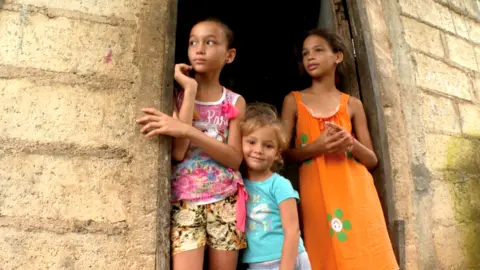
Marbeyis says among the fundamental issues in Aguacate – meals insecurity and water distribution – have been exacerbated by the facility cuts.
Her husband’s handbook labour additionally requires electrical energy and he’s caught at dwelling ready for the instruction to return to work. The Cuban Authorities was on account of recall state staff by Thursday – however to keep away from one other collapse within the grid, all non-essential work and faculties have now been suspended till subsequent week.
“It’s particularly laborious on the kids”, Marbeyis provides, her eyes tearing up, “as a result of after they say I need this or that, we now have nothing to present them.”
Residing and not using a dependable vitality supply is the brand new regular in locations like Aguacate. Many have been scuffling with energy shortages since across the begin of the Covid-19 pandemic, which coincided with a pointy financial downturn on the island.
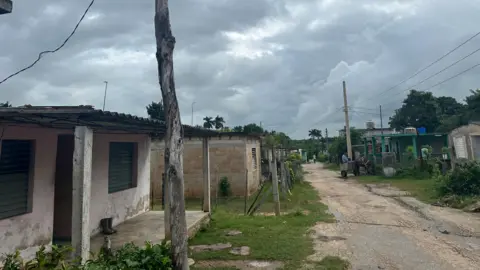
Maybe the largest downside for the Cuban State is that the sight of individuals cooking with firewood and charcoal within the twenty first Century is harking back to the poverty below dictator Fulgencio Bastista, who the revolutionaries ousted six-and-half many years in the past.
Amid all of it, on the north-eastern coast, the scenario acquired even worse. As folks had been nonetheless dealing with the blackout, Hurricane Oscar made landfall, bringing excessive winds, flash flooding and ripping roofs from houses.
The storm could have handed. However Cubans know that such is the precarious state of the island’s vitality infrastructure that the subsequent nationwide blackout might come at any time.




